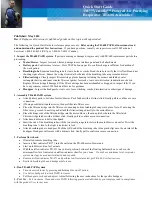
Subject to change without notice. Printed in U.S.A.
035-16408-001 Rev. B (101)
Copyright
©
by York International Corp. 2000. All rights reserved.
Supersedes: 035-16408-001 Rev. A (101)
Unitary
5005
Norman
Products
York
OK
Group
Drive
73069
NOTE:
The control with not operate on Y2 without a Y1 signal.
SYSTEM CONTROL BOARD FUNCTIONS
Refer to Figure 8 for view of Control Board.
Five Minute Anti-Short Cycle Timer
The control has a five minute time delay to prevent the sys-
tem from short cycling after a thermostat off cycle or power
interrupt. This five-minute delay is initiated following the com-
pletion of a first stage cooling call (Y1) or the 24v power up of
the control. During this mode the control will not respond to
any thermostat inputs and the LED will flash a code 1 at the
control board.
For servicing or during installation of the condensing unit, the
time delay may be by-passed by momentarily jumping the
two test pins when there is a call for cooling (Y1 or Y2).
Indoor Blower Operation
The indoor blower operation is controlled directly by the Y1 or
G thermostat signal for the first stage of cooling and by
Y2OUT from the control for the second stage of cooling. This
is done to allow the outdoor unit control to override the ther-
mostat control so that the indoor blower continues to operate
on high speed even though the call for Y2 is not present.
Additionally, during the five second switching from first to sec-
ond stage, the blower ramp up is delayed.
HeartBeat – LED flash rate of .5 sec. ON and .5 sec. OFF
Flash/Error Code – LED flash rate of .3 sec. ON and .3
sec. OFF for the number of codes and with a pause of 1.5
seconds between flash codes.
Resetting Fault Conditions
The control locks out the unit and does not permit it to run
when it detects certain fault conditions. Table 2 lists all the
modes indicated by the control. Control code "1" is a tempo-
rary five-minute lock-out (see Anti-short cycle above).
INSTRUCTING THE OWNER
Assist owner with processing warranty cards. Review Owners
Guide and provide a copy for the owner guidance on proper
operation and maintenance. Instruct the owner or the opera-
tor how to start, stop and adjust temperature setting.
The installer should also instruct the owner on proper opera-
tion and maintenance of all other system components.
INDICATIONS OF PROPER OPERATION
Cooling operation is the same as any conventional air condi-
tioning unit.
The following checks may be made to determine if the sys-
tem is operating properly:
1.
The outdoor fan should be running, with warm air being
discharged from the top of the unit.
2.
The indoor blower (furnace or air handler) will be operat-
ing, discharging cool air from the ducts.
3.
The vapor line at the outdoor unit will feel cool to the
touch.
4.
The liquid line at the outdoor unit will feel warm to the
touch.
If unit is not operating properly, check the following items
before calling a serviceman:
1.
Indoor section for dirty filter.
2.
Outdoor section for leaf or debris blockage.
Eliminate problem, turn off the thermostat for 10 seconds and
attempt start. Wait 5 minutes. If system does not start, call
service technician.
MAINTENANCE
1.
Dirt should not be allowed to accumulate on the outdoor
coils or other parts in the air circuit. Clean as often as
necessary to keep the unit clean. Use a brush, vacuum
cleaner attachment, or other suitable means.
2.
The outdoor fan motor is permanently lubricated and
does not require periodic oiling.
3.
If the coil needs to be cleaned, it should be washed with
Calgon CalClean (mix one part CalClean to seven parts
water). Allow solution to remain on coil for 30 minutes
before rinsing with clean water. Solution should not be
permitted to come in contact with painted surfaces.
4.
Refer to the furnace or air handler instructions for filter
and blower motor maintenance.
5.
The evaporator coil drain pan should be inspected and
cleaned regularly to prevent odors and assure proper
drainage.
When the system is functioning properly and the owner
has been fully instructed, secure the owner’s approval.
FIGURE 8 :
COMFORT ENHANCER
TM
CONTROL
BOARD
LED @
control
Description
24V @
X/L line
HeartBeat
Normal Operation
None
1 Flash
Compressor waiting to complete
Anti-short cycle period
None
On Steady
Control Failure
Yes
Off
No power or Control Failure
Yes
STATUS
EXTERNAL RLY
TEST
TEST
PINS
R
C
L
Y2
Y2 OUT
Y1
PS
M
LED
TS CONTROL






























